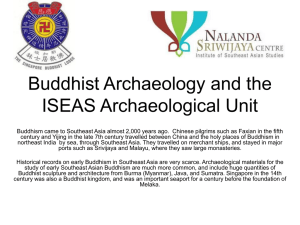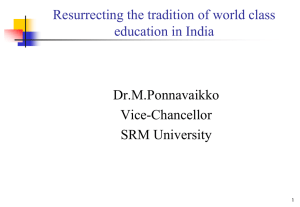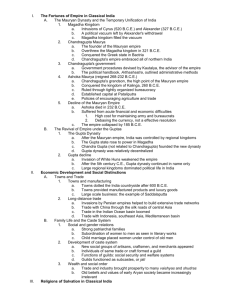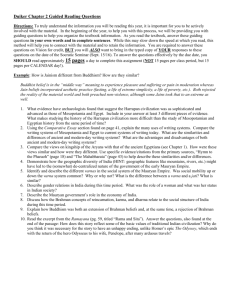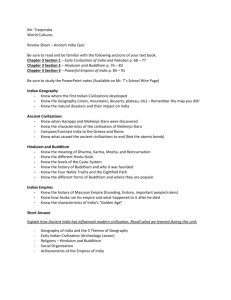Nalanda
advertisement
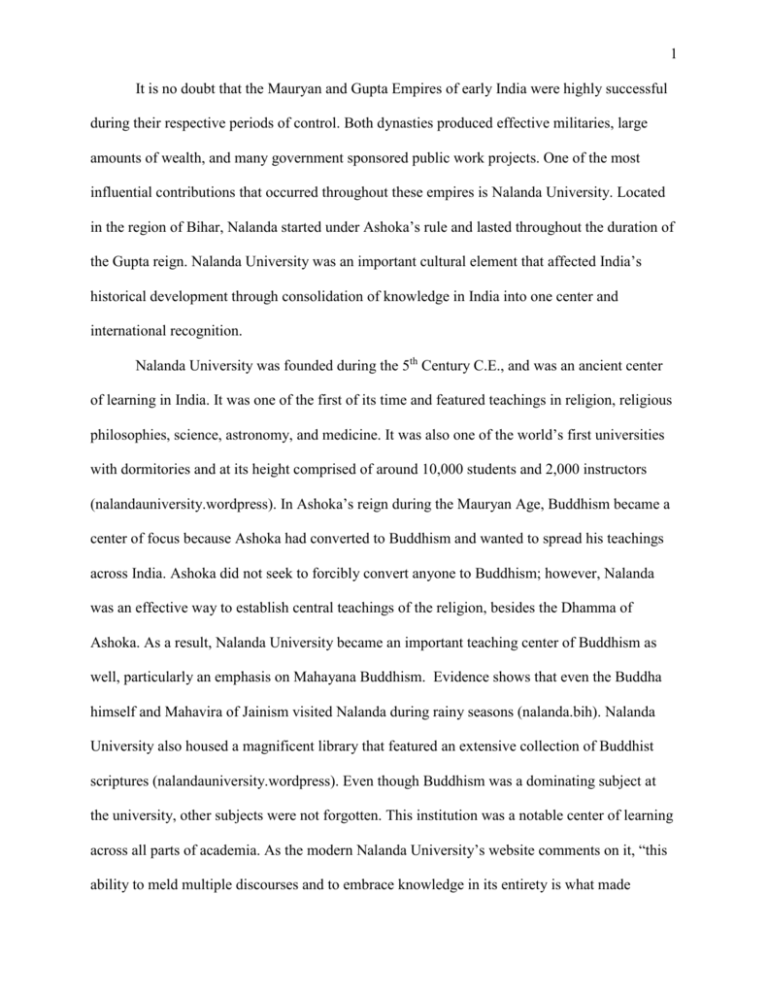
1 It is no doubt that the Mauryan and Gupta Empires of early India were highly successful during their respective periods of control. Both dynasties produced effective militaries, large amounts of wealth, and many government sponsored public work projects. One of the most influential contributions that occurred throughout these empires is Nalanda University. Located in the region of Bihar, Nalanda started under Ashoka’s rule and lasted throughout the duration of the Gupta reign. Nalanda University was an important cultural element that affected India’s historical development through consolidation of knowledge in India into one center and international recognition. Nalanda University was founded during the 5th Century C.E., and was an ancient center of learning in India. It was one of the first of its time and featured teachings in religion, religious philosophies, science, astronomy, and medicine. It was also one of the world’s first universities with dormitories and at its height comprised of around 10,000 students and 2,000 instructors (nalandauniversity.wordpress). In Ashoka’s reign during the Mauryan Age, Buddhism became a center of focus because Ashoka had converted to Buddhism and wanted to spread his teachings across India. Ashoka did not seek to forcibly convert anyone to Buddhism; however, Nalanda was an effective way to establish central teachings of the religion, besides the Dhamma of Ashoka. As a result, Nalanda University became an important teaching center of Buddhism as well, particularly an emphasis on Mahayana Buddhism. Evidence shows that even the Buddha himself and Mahavira of Jainism visited Nalanda during rainy seasons (nalanda.bih). Nalanda University also housed a magnificent library that featured an extensive collection of Buddhist scriptures (nalandauniversity.wordpress). Even though Buddhism was a dominating subject at the university, other subjects were not forgotten. This institution was a notable center of learning across all parts of academia. As the modern Nalanda University’s website comments on it, “this ability to meld multiple discourses and to embrace knowledge in its entirety is what made 2 Nalanda uniquely attractive for all seekers of pure knowledge” (nalandauniv.edu). Nalanda University continued to prosper after the fall of the Mauryan Empire into the Gupta Empire and Harsha’s time of reign. At its height, the university was massive in size and known excavations account for about 150,000 square meters. Detailed accounts from Xuan Zhang, a Chinese pilgrimage, reveal that about 90% of ruins have not been discovered (nalandauniversity.wordpress). The importance of Nalanda University to the historical development of India is that reinforced the concept of what it means to be an Indian. The university, like the Mauryan Empire, showed how Indians could unify and create something bigger than them. There were no universities in India prior to Nalanda and certainly no unification across the sub-continent. Nalanda University consolidated all topics of learning into one center where people were able to advance themselves intellectually and carry that knowledge to other pursuits. The overall culture of India was thus improved because a major center of learning, such as Nalanda, brought Indians together to learn whatever they wanted to pursue. Buddhism, for a time, found some central traction as a result of this institution and enjoyed the benefits of increased awareness and learning. Nalanda University also had an impact through its international connections. As the modern Nalanda University describes the connection, “the profound knowledge of the Nalanda teachers attracted scholars from places as distant as China, Korea, Japan, Tibet, Mongolia, Turkey, Sri Lanka, and South East Asia” (nalandauniv.edu). The university quickly became an internationally recognized symbol. Intellectuals and travellers all across Asia took notice of this new, revolutionary center of learning. One prominent visitor to Nalanda University was a Chinese traveller during the Tang Dynasty in China, named Xuan Zhang, and was known to have studied at Nalanda during the 7th Century A.D. In his book titled, Pilgrim to the West in the Tang Dynasty, Xuan Zhang recorded the culture, language, and history of over 140 different countries 3 (travelchinaguide.com). He recorded much of the known knowledge scholars have today on Nalanda, such as the sites of temples, Buddhist legends, and the physical layout of the university, as mentioned before. He left detailed accounts on Nalanda as well, including describing the temples and pavilions scattered throughout the massive complex. He described them as soaring over the skies and the monks being able to “…witness the birth of the winds and clouds” (nalandauniversitywordpress). The region of Bihar, where Nalanda was located, was rapidly growing into a central hub of India with the establishment of the Mauryan and Gupta dynasties. Many foreign contacts noticed the quick rise and prominence of these empires and took advantage of the opportunities of possible trade and exchanger. Nalanda University became an appealing and fascinating place to these distant visitors and encouraged more and more in the future to come and learn. As a result, India was able to establish itself for the first time in its history as a global image. Scholars and intellectuals from other nations brought with them their ideas and influences to Nalanda. The overall Indian culture and identity improved as a whole with these new cultural exchanges in learning and, not to mention, the economic benefits brought to the Mauryans and Guptas. Nalanda University was truly a pioneering element of its time on the Indian subcontinent. Never before a central power of knowledge had brought together intellectuals from far and wide as Nalanda did. Buddhism and other religions were able to effectively teach its doctrines in a structured setting leading to an increase in Indian culture. Nalanda also attracted many foreign contacts, bringing a wave of benefits in Indian culture because of the cultural exchanges that were able to take place. In all, Nalanda University was the first of its kind and was a “seamless co-existence between nature and man and between living and learning” (nalandauniv.edu). 4 Works Cited "History." District Administration of Nalanda. Web. 15 Nov. 2014. <http://nalanda.bih.nic.in/history.asp>. "Nalanda University." Nalanda University. Web. 15 Nov. 2014. <http://nalandauniversity.wordpress.com/about/>. "The Nalanda University." The Nalanda University. Web. 15 Nov. 2014. <http://www.nalandauniv.edu.in/abt-history.html>. "Xuanzang, Tang Monk, Pilgrim to the West in the Tang Dynasty." Xuanzang, Tang Monk, Pilgrim to the West in the Tang Dynasty. Web. 15 Nov. 2014. <http://www.travelchinaguide.com/silk-road/history/traveler-xuanzang.htm>. The Impact of Nalanda University on Indian Development Cadet Bowen JL HI-327X: The History of India November 18, 2014 Help Received: See Bibliography
